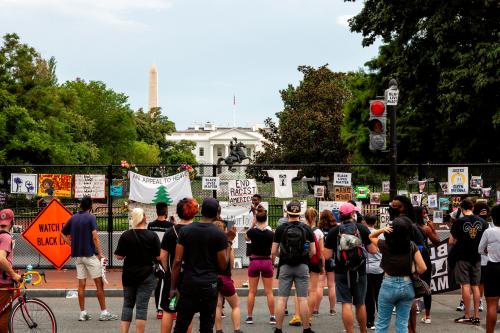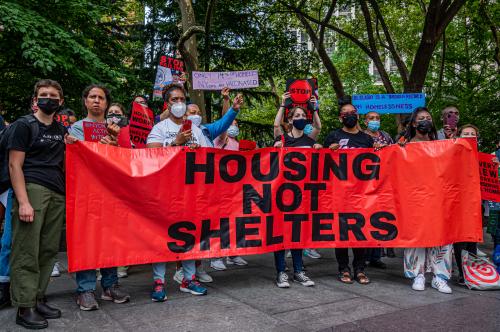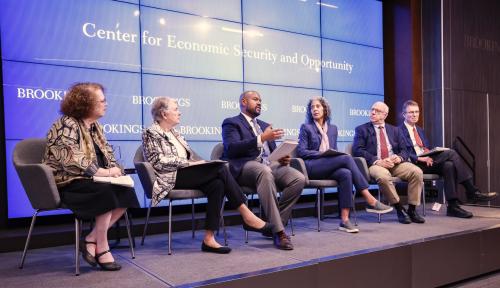The wealth gap between Black and white Americans is persistent and substantial. Data show that the median white household has at least 10 times the wealth of the median Black household; average wealth in white households is six or seven times the average wealth in Black households. Even after controlling for observable variables, a substantial gap remains. The racial wealth gap has grown over the last 30 years rather than narrowing.
Many policies aimed at addressing this disparity focus narrowly on wealth–savings programs, retirement income efforts, and “baby bonds”, for example. Here, we take a broader view of wealth as accumulating over the entire life cycle and even over generations. Through this lens, we see that the wealth gap can be affected by a wide range of policies that target child poverty, education, earnings, and other facets of economic well-being. The Earned Income Tax Credit (EITC) and the Child Tax Credit (CTC) thus carry implications for the racial wealth gap because they offer chances to increase income and financial stability across a person’s lifetime. Policies that reform both the EITC and CTC would narrow the racial wealth gap.
Earned Income Tax Credit
The EITC is one of the most important anti-poverty programs in the United States, providing benefits to 25 million workers and families in 2021. The EITC certainly benefits both Black and white households: It raises the checking and savings account balances among all low-income households, especially among low-income single mothers. It also reduces debt among single mothers. The EITC lowers income inequality between Black and white households by roughly 5 to 10% each year.
Although Black children are more likely to live in an EITC-eligible family than white children, the EITC may not have any statistically significant effect on Black household wealth but increases white household wealth. This suggests that the EITC, under current law, may not narrow the racial wealth gap and may even widen it.
Eligibility and exposure to the EITC could drive the credit’s effects on the racial wealth gap. Conventional belief holds that the “typical” EITC recipient is Black. Dorothy Brown pushes back against this idea, showing that many Black households have income that is either too low or too high to qualify for the EITC and are likely to receive a lower benefit per child than white households. Take-up rates among Black households eligible for the EITC have tended to be higher than among eligible white households. However, Black parents below 200% of the poverty line are also slightly less likely than white low-income parents to say that they have heard of or received the EITC, suggesting that white households have been better able to take advantage of the EITC.
Under the American Rescue Plan Act (ARPA), passed in spring 2021, the “childless” EITC, or the EITC granted to low-income workers without a qualifying child, was nearly tripled for the rest of 2021. ARPA also expanded eligibility for the “childless” EITC, for the first time including workers between the ages of 19 and 25.
Policy changes that would extend both expansions would help thousands of Black workers, especially young Black workers, and would be an important step in alleviating poverty for the only group that is taxed into poverty. Expanding the childless EITC would raise the wealth of Black households but its effect on closing the racial wealth gap is less clear.
Child Tax Credit
The CTC helps reduce poverty substantially among families with children. Under current law, benefits phase in at the lowest end of the income spectrum, then gradually phase out at higher incomes. The CTC is also only partially refundable, leaving the lowest-income households eligible for only a portion of the credit. ARPA made the CTC fully refundable for 2021. Policy changes that would make it fully refundable would have significant positive equity impacts on experiences of poverty.
Black children are far more likely to live in poverty than white children are, making the CTC and its refundability particularly important for Black children. While three-quarters of white children are eligible for the full CTC benefit, only half of Black children are. However, under a fully refundable credit, 99% of Black children would be eligible for the full CTC, and racial gaps in eligibility would be completely eliminated—in other words, much of the inequality in CTC eligibility stems not from Black children being better off, but from their being, on average, worse off than their white peers. Indeed, early evidence from the expanded CTC in place for 2021 indicates that Black and white children are equally—or Black children are somewhat more—likely to benefit from the CTC. The expanded CTC also reduced food insufficiency by similar levels in both Black and white households.
If we make CTC benefits more racially equitable more Black children will be lifted out of poverty and able to reach their aspirations.
Conclusion
Reforms to the EITC and the CTC are important to addressing the endemic racial wealth gap. A fully refundable CTC would extend full benefits to Black children, setting them up better for their adult lives by investing in their childhood. Expanding eligibility for and increasing the “childless” EITC would help thousands of low-income Black workers, especially those at the beginning of their careers, although it carries fewer implications for the racial wealth gap. A serious consideration of these provisions would help take full advantage of these anti-poverty programs’ potential for racial equity.






Commentary
Narrowing the racial wealth gap using the EITC and CTC
February 2, 2022